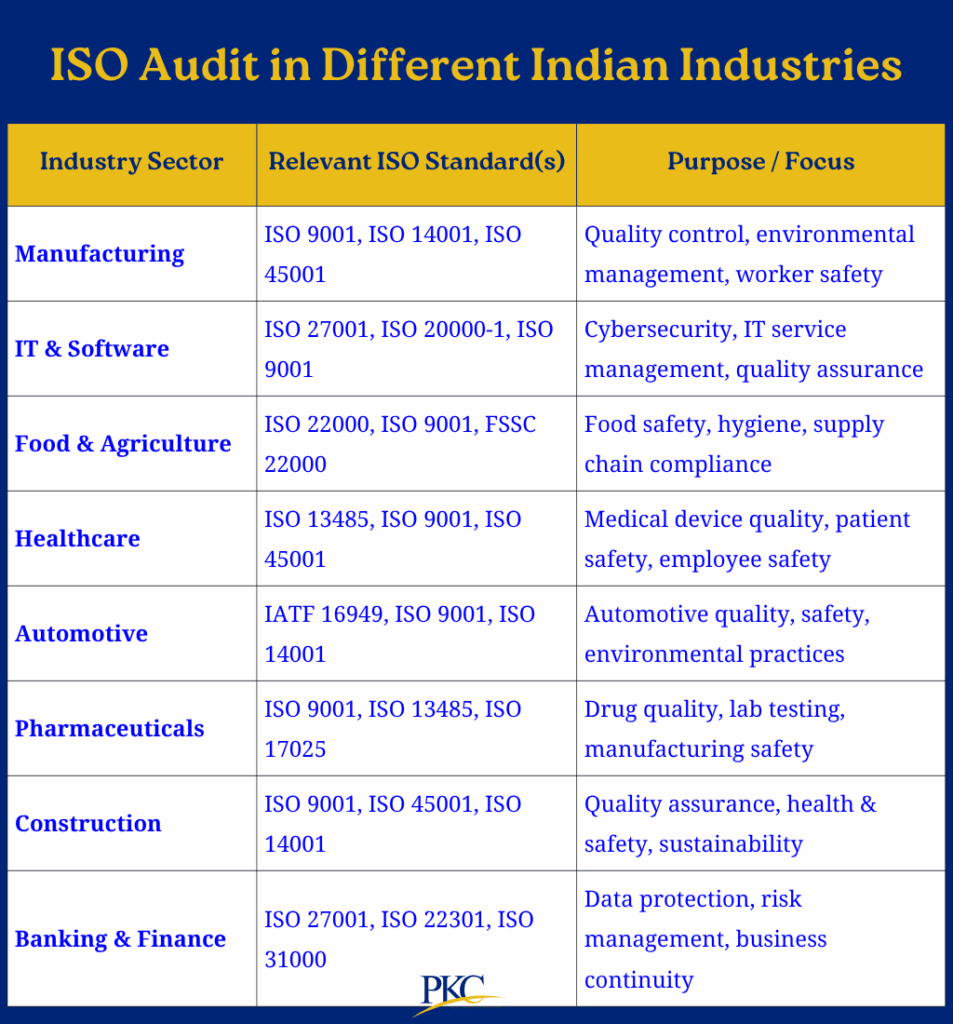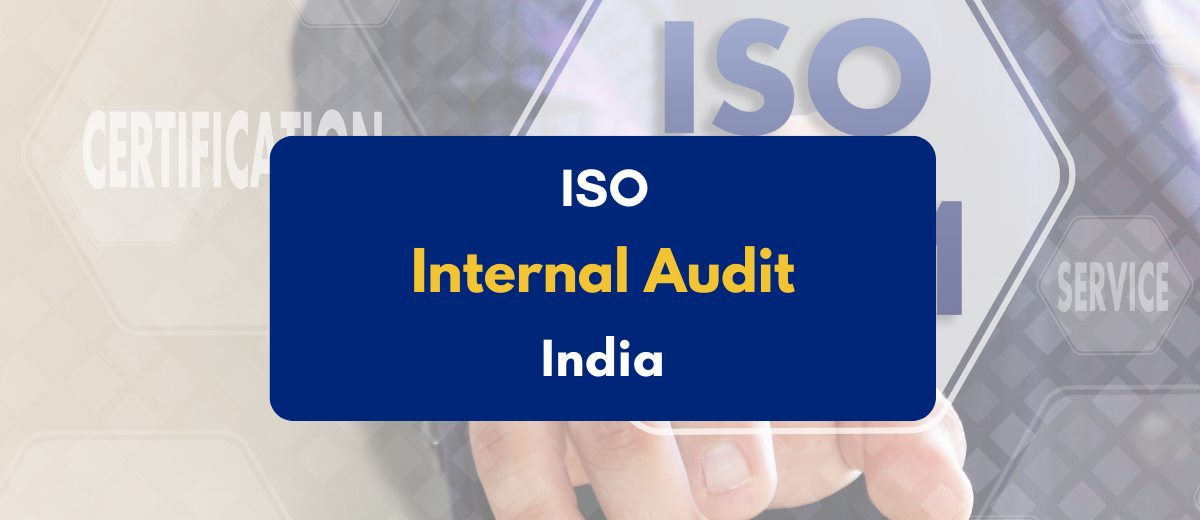ISO internal audit is a mandatory requirement for certified companies. They help identify issues early, address them quickly, and ensure a smooth and successful external audit.
Understand with us the basics of these audits, how to conduct them and create your own ISO audit checklist with the help of the sample we provide.
What is ISO Internal Audit & Why It’s Important?
An ISO internal audit is a systematic, independent, and documented self-check done inside a company to make sure you’re following the rules of ISO standard(s).
These standards may include ISO 9001 (Quality Management System), ISO 14001 (Environmental Management System), or ISO 27001 (Information Security Management System) or ISO 45001 (Occupational Health & Safety Management System)
Here are its main characteristics:
- Internal: Conducted by your own internal audit team or an outsourced firm like PKC Management Consulting acting on behalf of management.
- Systematic: Follows a defined plan, scope, and methodology based on the standard and your internal procedures.
- Objective & Independent: Auditors should be impartial, not auditing their own work directly, to ensure unbiased findings.
- Documented: Findings, evidence, and reports are formally recorded.
- Periodic: Conducted at planned intervals (e.g., annually, bi-annually, quarterly depending on the standard and organization size/risk).
Importance of ISO Internal Audits in India
- External Certification/Surveillance Audit Preparation: Help identify and fix gaps before external audits, increasing the chances of smooth certification.
- Continuous Compliance & Maintaining Certification: Ensure ongoing compliance with ISO standards, especially in heavily regulated Indian sectors.
- Effective Risk Management: Identify potential risks early, helping businesses prevent failures and avoid costly consequences.
- Verify System Effectiveness: ISO audits check whether documented procedures are followed and deliver real results.
- Enhance Employee Awareness & Engagement: Engages staff, clarifies roles, and fosters ownership of quality systems.
- Demonstrate Due Diligence: Show regulators and stakeholders that the company proactively ensures compliance.
- Meet Customer & Market Requirements: Many global clients require evidence of active internal audits as part of ISO certification.
Key ISO Standards Requiring Internal Audit in India
Here’s a breakdown of the key ISO standards requiring internal audits in India:
ISO 9001: Quality Management System (QMS)
This is the most popular ISO standard in India and applies to almost every industry, from manufacturing to IT.
This standard is critical for exporters, manufacturers, and service providers to access markets, reduce defects, and build reputation.
It ensures
- Consistent product/service quality
- Customer satisfaction
- Process improvement.
ISO 14001: Environmental Management System (EMS)
This standard focuses on how your business affects the environment.
It is vital for compliance with strict environmental regulations, managing waste/emissions (especially in manufacturing), resource efficiency (water/energy), and meeting ESG expectations.
Audits check:
- Adherence to environmental laws in India
- Pollution control processes work
- Waste and energy management.
ISO 27001: Information Security Management System (ISMS)
This standard verifies protection of sensitive data against breaches and cyber threats.
Mainly used by
- Non-negotiable for IT/ITeS companies, BPOs, banks, and any firm handling customer data
- Critical for client contracts, cybersecurity preparedness, and upcoming data privacy laws
ISO 45001: Occupational Health and Safety Management System
This standard is essential for companies with factories, warehouses, or field workers. It is crucial in high-risk industries (construction, manufacturing, chemicals) to prevent accidents, reduce liability, ensure statutory compliance, and improve worker welfare.
It proactively identifies safety risks, ensures legal compliance (Factories Act, etc.), and protects worker well-being.
Audits check:
- Workplace safety standards
- Accident prevention systems
- Legal compliance with Indian labour laws
ISO 22000: Food Safety Management System
Used in food processing, hospitality, agriculture, and supply chain sectors.
It prevents food contamination, ensures safe products, and meets hygiene standards.
Essential for:
- FSSAI compliance
- Food exporters, processors, retailers, and restaurants to prevent recalls
- Protect consumers and maintain brand trust
ISO 50001: Energy Management System
Helpful for large-scale industries in India where energy costs are high.
It ensures systematic reduction in energy consumption and costs.
Key for energy-intensive industries to comply with BEE (Bureau of Energy Efficiency) standards, manage rising energy costs, and support sustainability goals.
Audits look into:
- Energy usage
- Efficiency improvements
- Compliance with Indian energy standards
ISO 13485: Medical Devices – Quality Management
This standard ensures medical devices are safe, effective, and meet stringent quality/regulatory requirements.
These are mandatory for manufacturers and distributors to comply with CDSCO regulations, access global markets, and ensure patient safety.
Specific internal audit focus on
- Design
- Production
- Regulatory compliance
IATF 16949: Automotive Quality Management
This standard is non-negotiable for Indian auto component suppliers to join global OEM supply chains (like Tata, Mahindra, Maruti Suzuki, or international players).
It drives precision and quality.
Audits help ensure:
- Defect prevention
- Process capability
- Supply chain reliability
ISO 20000-1: IT Service Management
This standard requires audits to verify IT service delivery meets SLAs and processes.
The audits ensure reliable, consistent, and customer-focused IT services.
Important for IT service providers (domestic and export) to demonstrate service quality and meet client contractual obligations.

Step-by-Step ISO Internal Audit Process in India
The process of ISO audit can vary from one industry to another. However, here are the steps that most of the audits follow:
Step 1: Define Audit Scope, Objectives & Team
- Clarify what and why you’re auditing (e.g., annual check, specific processes, ISO clauses).
- Focus on high-risk/regulatory areas such as FSSAI, CPCB, server rooms, etc.
- Choose trained internal team or unbiased auditors from trusted firms like PKC
- Ensure independence despite hierarchies; consider local language skills and provide training.
Step 2: Develop Audit Plan & Checklist
- Schedule dates, departments, auditors, standards to be covered
- Create a checklist based on ISO standards, SOPs, past audits, and objectives.
- Consider holidays, shift patterns, peak seasons. Keep checklists simple, localized, and based on past Non Conformities (NCs).
Step 3: Conduct Opening Meeting
- Confirm scope, method, and logistics with auditee management.
- Keep it formal yet open. Stress upon system improvement rather than blame.
Step 4: Gather Audit Evidence
- Use interviews, observations, and document reviews.
- Validate verbal claims with records. Be aware of cultural nuances and practical ground realities. Document thoroughly.
Step 5: Evaluate Evidence & Identify Findings
- Compare findings against ISO standards and internal procedures.
- Classify as Conformity, Nonconformity (Major/Minor), or Opportunity for Improvement (OFI).
- Be factual, specific, and traceable in documentation. Avoid vague wording.
Step 6: Communicate & Document Results
- Share major issues daily (if needed) to avoid surprises.
- Draft report and include scope, team, summary of findings with evidence.
- In the closing meeting review NCs/OFIs, clarify doubts, assign responsibilities.
- Use tables, maintain clarity. Ensure Management Representative (MR) reviews and all NCs have owners.
Step 7: Issue Final Audit Report
- Finalize and distribute the approved audit report to relevant management and process owners.
Step 8: Corrective Actions & Follow-up
- Analyze root causes – Root Cause Analysis (RCA) and define action plans with timelines and responsibilities – (CAPA)
- Carry out actions as planned.
- Verify closure via re-audit or evidence review.
- Avoid surface-level fixes. MR must monitor progress; verify that changes work in practice.
Step 9: Input to Management Review
- Present audit trends, systemic issues, and CAPA status at the Management Review Meeting.
- Ensure leadership uses findings for strategic improvements. Push for resource allocation if needed.
Frequency of ISO Internal Audits in India
The frequency of ISO internal audits in India is not fixed by the ISO standard itself. It is to be determined by each organization based on risk, complexity, and context.
The key factors that determine frequency are:
Standard Requirements:
Clause 9.2 mandates audits at “planned intervals” – leaving flexibility but requiring justification.
Risk & Complexity
- High-risk sectors (e.g., pharma, chemicals, construction): Quarterly or bi-annual audits.
- Multi-location operations: Each site audited annually (staggered schedule).
- Critical processes (e.g., production, data security): Audited more frequently (e.g., every 6 months).
Regulatory Pressure
Industries under strict regulators (FSSAI, CPCB, SEBI) often need quarterly audits to pre-empt compliance gaps.
Company Size & Maturity
- SMEs: Start with annual full-system audits + quarterly mini-audits of high-impact areas.
- Large/Mature companies: Annual system-wide audit + semi-annual process/departmental audits.
Performance History
Organizations with past non-conformities (NCs) or customer complaints increase frequency until stability is achieved.
Common ISO Audit Schedules by Industry
| Industry | Typical Audit Frequency |
| Manufacturing | Every 6–12 months |
| IT & Data Security | Quarterly or Bi-Annually |
| Pharma & Healthcare | Every 3–6 months |
| Food Industry | Bi-Annually |
| Small Businesses | Annually (minimum) |
Sample Checklists Used in ISO Internal Audits
ISO audit checklist varies with the specific ISO standard(s) being audited and the organization’s industry, size, and complexity.
Here’s how a checklist for an ISO audit will look like in India. The checklist we share is suitable for ISO 9001, 14001, 45001, 27001, and 50001.
It covers all major clauses from leadership to improvement.
ISO Internal Audit: Internal Vs External Vs PKC India
ISO audits can be conducted by internal auditors or can be outsourced to CAs or consulting firms like PKC Management Consulting.
Here’s what you can expect
| Aspect | Internal Audit | External Audit | PKC India |
| Who | Your team | ISO certifier | PKC’s expert auditors |
| Cost | Low | High | Medium |
| Expertise | Varies | Very high | High + India-specific |
| Bias | Possible | Independent | Independent |
| Goal | Check internal processes | ISO certification | Compliance + improvement |
| Support | Limited | None after audit | Ongoing support |
| Best for | Small teams | Certification requirement | Audit readiness + compliance |
Frequently Asked Questions
1. Is ISO internal audit mandatory in India?
Yes, it’s required for all ISO-certified companies in India. Most companies are required to perform it at least once a year to stay compliant.
2. Who can perform an ISO internal audit?
Trained internal staff or third-party consultants like PKC Management Consulting can perform these audits. The auditor must be independent of the process being audited.
3. What are the benefits of ISO internal audit?
It helps improve quality, reduce risks, and prepare for external audits. It also builds trust with customers and regulators.
4. What documents are needed for ISO internal audit?
You need an audit plan, checklist, audit report, and corrective action reports. All documents should be well-organized and traceable.
5. How long does an ISO audit take?
It usually takes 1–5 days depending on company size and complexity. Larger companies with more processes take longer.

 Expert verified
Expert verified 

